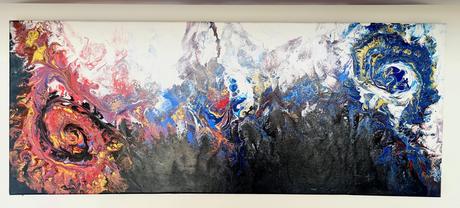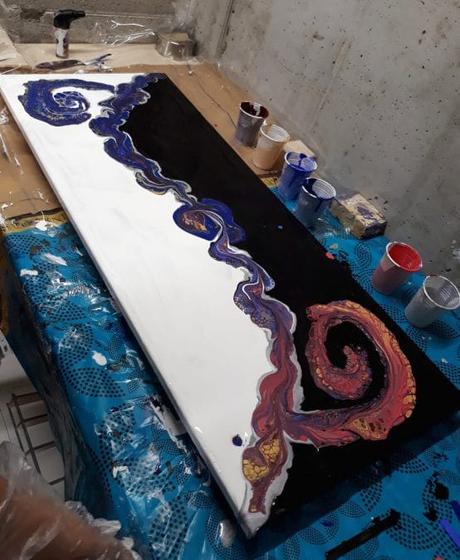Fun with funnel: our favorite Acrylic Pouring technique | #LRCrafts - DIY Passion: if you can think it, you can make it
Acrylic pouring is a craft my husband and I both love to come back from time to time. It’s a simple yet effective way of creating stunning paintings without the need for drawing skills.
Acrylic pouring is a fluid painting technique, where you use a liquid mix of acrylic colors of your choice diluted with a pouring medium. You have then several ways to pour them onto the canvas and let the liquid paint flow, move and combine to end in the final appearance you want. Easy, yes, but the result could also differ a lot from your expectations, with the paint doesn’t behaving as you thought it would. It happened once to us that the color mix ended up so different from our initial plan that we decided to pour again onto the very same canvas and hide the original painting under a new one – and better we did it!
Among the many different techniques available (the classic dirty pour, string pull, colander pour, flip cup, baloon dip and many more), the funnel pour holds a special place in our hearts. It’s the one that consistently gives us the most satisfying results and is, by far, the most fun to create for us.
There’s a piece in particular, a long, rectangular canvas, that’s the perfect representation of why we adore this technique so much.
Acrylic pouring
Click for the finished project detailed photos
https://youtube.com/shorts/EiyJwg_Cr1ATo begin, we divided the canvas into two sections: the upper half was coated in white paint, while the bottom half was covered in black. This provided a striking contrast and served as the base for our painting.
For this pour, we prepared two separate funnels. The funnel we used on the left was primarily blue, while the one on the right featured pink as its main color. In both funnels we stacked the colors one by one, each a mixture of acrylic paint and Floetrol as the pouring medium, in nearly equal amounts. We also added two drops of silicone oil to each mix to encourage the formation of beautiful cells.
Starting in the middle of the canvas, right where the white and black base layers met, we poured the left funnel, slowly guiding it along the dividing line and drawing a spiral at the end of the canvas, on the white side. Then we did the same with the right funnel, starting at the same spot and proceding towards the right, drawing a spiral this time on the black side.
The transition between the two sections felt almost like watching two different worlds meeting in the center. As the funnels slowly procedeed, beautiful cells started to emerge and the colors flew and mixed.
The silicone oil worked its magic, bringing out vibrant cells that added texture and depth to the painting. We were especially thrilled with the way the two halves of the canvas mirrored each other, with the blue funnel dominating the left side and the pink taking charge on the right.
To enhance the design, my husband used a straw to blow the colors outward from the funnel pour, creating stunning effects and helping the colors burst and swirl into intricate, fractal-like patterns.
Blowing with a straw allows for subtle adjustments, perfect when you want to create detailed, soft effects. It offers a delicate touch, letting us manipulate the paint slowly, ensuring that colors didn’t overblend. For stronger bursts or to cover larger areas, some artists prefer using a hair dryer or similar tools, providing more power for spreading the paint and creating dramatic effects.
Additionally, to bring out the cells more prominently, we used a blowtorch. The heat interacts with the silicone oil in the paint mixture, encouraging the cells to expand and pop up through the layers of color. This adds another dimension to the painting, giving it texture and depth, making the painting even more dynamic.


This is one of the acrylic pours we are most proud of, and it’s also our biggest one to date. Acrylic pouring with the funnel technique is the one that gave us the most gratifying results, and by far the one we enjoy the most. We’re always fascinated by how the color emerges from the tip of the funnel and spreads across the canvas, creating beautiful, unexpected patterns.
Also, we’d love to hear from you! What’s your favorite acrylic pouring technique and why? Let’s discuss and exchange experiences and tips in the comments. Whether you’re a fan of funnel pours, swipes or something else, we’re always excited to learn new approaches!
by Rici86.

